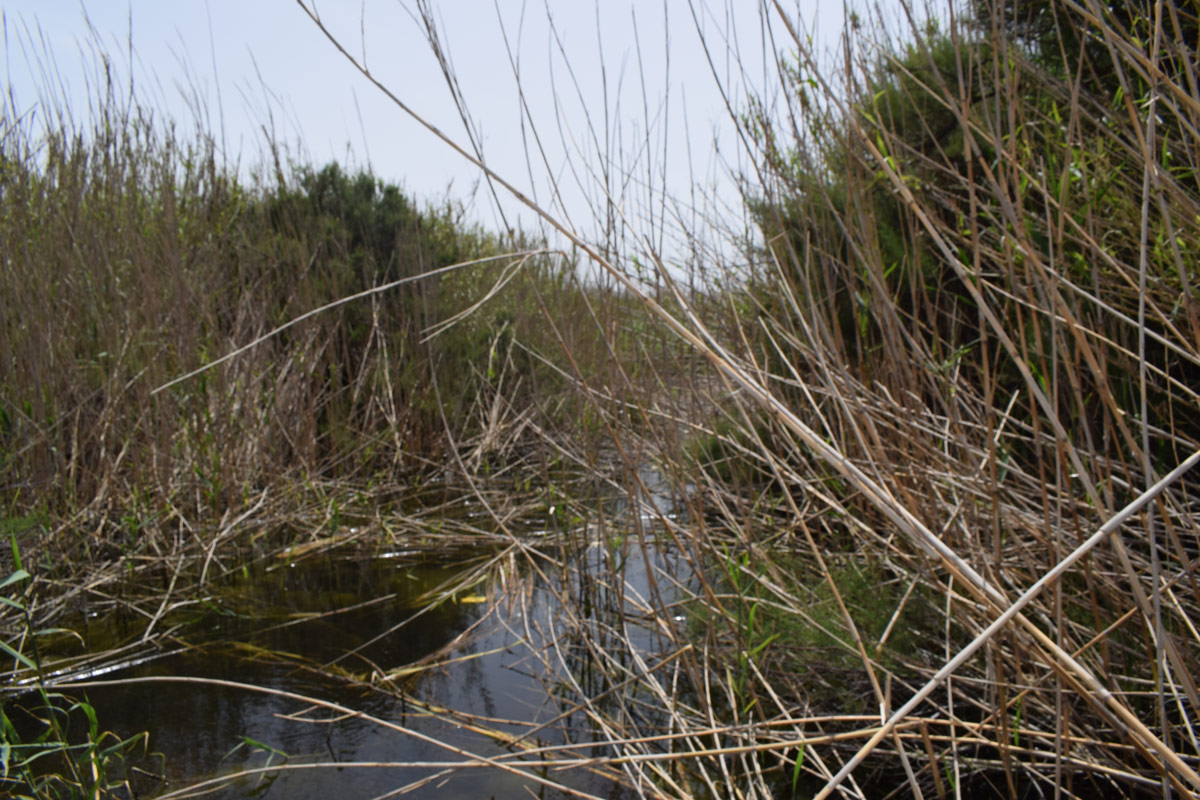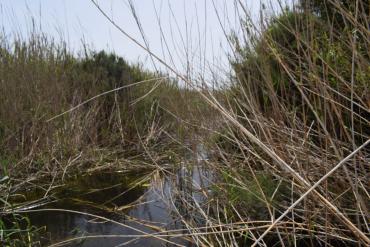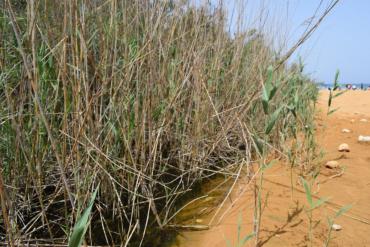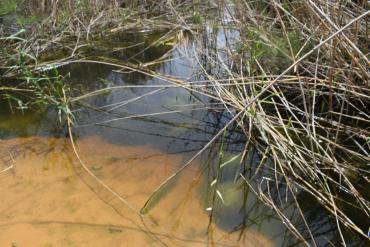GOZ005 - Ir-Ramla
Description
This site lies within a Special Area of Conservation (SAC) and is located north-east of the island of Gozo. The seaward area of the site borders Il-Grigal ta’ Malta Marine Protected Area. The site includes a water body that receives water from the mouth of Wied ir-Ramla. Marshlands are supported during the wet season. On the coastal side, this site is one of the few sites in the Maltese Islands still supporting sand dunes. Southern riparian galleries and thickets dominated by Tamarisk trees and Chaste Trees (to a lesser extent) grow on the banks of the water body. The dune system at Ramla is almost intact, and the best example in the Maltese Islands of this habitat type. The sand dunes at Ramla host a variety of rare and endangered invertebrate species, some of which are only found within this SAC. Several activities exert pressure on the ecology of the site. Ramla Bay is an important recreation location for tourists and locals, which can lead to littering, disturbance and trampling. Limited parking space is present near the site and a field that is used for agriculture during winter is used as a parking lot during the summer months. Haphazard parking could lead to trampling, disturbance and habitat modification. Parts of the site are seriously threatened by fires from illegal barbecues and in the past these have led to the loss of populations of the rare Bushy Restharrow (Ononis natrix). Various kiosks and restaurants and mobile kiosks are found within the catchment area. Camping is also practiced on the car park where campers stay throughout the summer months as well as along the coastal stretch above the dunes just west of Ramla beach. The dune vegetation can be negatively affected by excessive trampling and overuse of the area, including from camping, caravans and off-roading, all of which are prohibited at this site. The more recent recreational pursuit known as bouldering may lead to soil erosion and. The importance of the site for recreation has resulted in several regular interventions and impacts that can affect the hydrologic regime of the area. Such interventions have included the removal of pebbles from the beach, the removal of Posidonia from the beach, pollution of Ramla Valley’s water course from agriculture, and over-abstraction from the aquifer affecting groundwater quality.Alien species damage ecosystems and communities by out-competing the native species. The most damaging invasive species at Ramla include the Giant Reed, Kaffir Fig, Cape Sorrel and the grapevine. The cover of the Giant Reed and the grapevine is increasing in view of the abandonment of former agricultural land backing the dune area. Care is also needed when implementing afforestation schemes; Tamarisk trees were planted in the area in the past, some of which are not the naturally occurring species for the Maltese Islands. The introduction of atypical species affects soil nutrients and pH conditions, negatively affecting the process of sand stabilisation. On the other hand, at this site, the planting of the French Tamarisk allowed the dune to increase in extent and also allowed the development of fixed dunes.

Wetland data
Basic information
| Wetland location: | Marine/Coastal |
| Wetland type: | Natural |
| Wetland area: | 0.30 Ha |
| Hydrological interaction: | Yes |
| Water salinity: | Brackish (5.0-18.0 g/l) |
| Type of fresh water input: | Catchment area (precipitation) |
| Surface water runoff | Other |
| Open water area (%): | 5 - 25 |
| Hydroperiod: | Permanent |
Geographic information
| Census district: | Gozo and Comino |
| Island: | Gozo |
| Local council: | Ix-Xaghra |
| Longitude: | 14.283640 East |
| Latitude: | 36.060940 North |
Wetland condition
| Wetland status (MEDWET): | 2 - Original habitats/landform still predominant (>50%) |
Ramsar wetland type
| Type | Coverage (%) |
| J -- Coastal brackish/saline lagoons; brackish to saline lagoons with at least one relatively narrow connection to the sea |
Property status
| Public |
| Protection status category | Protection status subcategory | Area's name | Code | Coverage area (%) | Legislation |
| National | Area of Ecological Importance | Ramla l-Hamra, Ghawdex | 14812 | 100 | Development Planning Act (Act VII of 2016) |
| National | Protected Beaches | Ir-Ramla l-Hamra | 346048 | 47 | Environment Protection Act (Act I of 2016) |
| International | Special Areas of Conservation - International Importance | L-Inhawi tar-Ramla | 330733 | 100 | Environment Protection Act (Act I of 2016) |
| Other | Scheduling - Archaeology | Buffer Zone for the Remains of a Roman Villa | 93 |
CDDA protection status
| CDDA code | CDDA category |
| MT01 | Area of Ecological Importance |
| MT12 | Protected Beaches |
| MT11 | Special Areas of Conservation - International Importance |
Ecosystem services
| Type of ecosystem service | Ecosystem service | Scale of Βenefit (%) | Importance |
| Supporting services | Provision of habitat | ||
| Regulatory services | Water purification | ||
| Regulatory services | Water regulation |
Activities on wetland
| Activity | Intensity |
| 010 = Habitat conservation | Low |
| 030 = Species conservation | Medium |
| 701 = water pollution | Low |
| 790 = Other pollution/human impacts/activities | Low |
| 952 = eutrophication | Low |
| 954 = invasion by a species | Medium |
Activities on catchment area
| Activity | Intensity |
| 100 = Cultivation | Low |
| 110 = Use of pesticides | Low |
| 120 = Fertilisation | Low |
| 130 = Irrigation | Low |
| 502 = roads motorways | High |
| 621 = nautical sports | High |
| 701 = water pollution | Low |
| 790 = Other pollution/human impacts/activities | Medium |
| 954 = invasion by a species | Medium |
Impacts
| Impact | Intensity |
| EB- = Increase in aesthetic qualities | Low |
| ED- = Increase in sediment removal/retention | Medium |
| EP- = Reduction of salt intrusion potential | Low |
| ES- = Increase in water supply | Low |
| EU- = Increase of tourist/recreation potential | Low |
| PU- = Increase of turbidity | Medium |
Habitat types
| Type | Coverage (%) |
| 1210 Annual vegetation of drift lines | < 5 |
| 1240 Vegetated sea cliffs of the Mediterranean coasts with endemic Limonium spp. | < 5 |
| 2110 Embryonic shifting dunes | < 5 |
| 2210 Crucianellion maritimae fixed beach dunes | < 5 |
| 2220 Dunes with Euphorbia terracina | < 5 |
| 92D0 Southern riparian galleries and thickets (Nerio-Tamaricetea and Securinegion tinctoriae) | 76 - 95 |
Vegetation types
| Type | Coverage (%) |
| Halophytic | 5 - 25 |
| Emergent | |
| Ammophilous | 76 - 95 |
| Wet meadow | |
| Shrubby / Arborescent | 5 - 25 |
Flora
| Species | Presence status | References |
| Arthrocnemum glaucum | ||
| Arundo donax | ||
| Elytrigia juncea | ||
| Eryngium maritimum | ||
| Euphorbia paralias | ||
| Jacobaea crithmoides | ||
| Juncus sp. | ||
| Medicago marina | ||
| Opuntia ficus-indica | ||
| Pancratium maritimum | ||
| Salsola kali | ||
| Sporobulus pungens | ||
| Tamarix africana | ||
| Vitex agnus-castus |
Fauna
| Mammals | Presence status in wetland | References | |
| Crocidura sicula calypso (Hutterer, 1991) | |||
| Erinaceus algirus (Lereboullet, 1842) | |||
| Pipistrellus pipistrellus (Schreber, 1774) | |||
Birds |
Number of individuals |
Nesting |
References |
| Apus apus (Linnaeus, 1758) | |||
| Hirundo rustica (Linnaeus, 1758) | |||
Reptiles |
Presence status in wetland |
References |
|
| Chalcides ocellatus tiligugu (Gmelin, 1789) | |||
| Chamaeleo chamaeleon (Linnaeus, 1758) | |||
| Coluber viridiflavus carbonarius (Bonaparte, 1833) | |||
| Podarcis filfolensis maltensis (Mertens, 1921) | |||
Invertebrates |
Presence status in wetland |
References |
|
| Argiope lobata (Pallas, 1772) | |||
| Nemesia macrocephala (Ausserer, 1871) | |||
| Synema globosum (Fabricius, 1775) | |||
| Anthicus fenestratus (W.L.E. Schmidt, 1842) | |||
| Eurynebria spp. | |||
| Harpalus spp. | |||
| Masoreus spp. | |||
| Ophonus spp. | |||
| Othiorhynchus spp. | |||
| Hypocaccus dimidatus (Illiger, 1807) | |||
| Xenonychus spp. | |||
| Pseudoseriscius cameroni (Reitter, 1902) | |||
| Stenosis schembrii (Canzoneri, 1979) | |||
| Xanthomus pallidus (Linnaeus, 1758) | |||
| Odontellina sexoculata (Deharveng, 1981) | |||
| Aphis spp. | |||
| Graphosoma lineatum spp. Italicum (O.F. Müller, 1766) | |||
| Apis mellifera (Linnaeus, 1758) | |||
| Bembecinus tridens (Fabricius, 1781) | |||
| Bembix oculata (Panzer, 1801) | |||
| Cerceris quadricinta (Panzer,1799) | |||
| Philanthus raptor siculus (Giordani Soika, 1944) | |||
| Camponotus barbaricus (Emery, 1905) | |||
| Crematogaster scutellaris (Olivier, 1792) | |||
| Leptothorax spp. | |||
| Messor capitatus (Latreille, 1798) | |||
| Halictus fulvipes (Klug, 1817) | |||
| Ammophila heydeni (Dahlbom, 1845) | |||
| Prionyx lividocinctus (A. Costa, 1861) | |||
| Sphex pruinosus (Germar, 1817) | |||
| Polistes omissus (Linnaeus, 1758) | |||
| Vanessa cardui (Linnaeus, 1758) | |||
| Colias croceus (Geoffroy, 1785) | |||
| Pieris brassicae (Linnaeus, 1758) | |||
| Macronemurus appendiculatus (Latreille, 1807) | |||
| Anax imperator (Leach, 1815) | |||
| Sympetrum fonscolombii (Selys, 1840) | |||
| Anacridium aegyptium (Linnaeus, 1764) | |||
| Brachytrupes megacephalus (Lefèvre, 1827) | |||
| Talitrus saltator (Montagu, 1808) | |||
| Porcellionides pruinosus (Brandt, 1833) | |||
| Tylos europaeus (Arcangeli, 1938) | |||
| Tylos latreillei sardous (Arcangeli, 1938) | |||
| Cochlicella conoidea (Draparnaud, 1801) |
Adi Epsilon Consortium (2014a) L-Inhawi tar-Ramla – Natura 2000 Management Plan (SAC). Prepared for the Malta Environment and Planning Authority under CT3101/2011. San Gwann, Malta, pp. 112 + Annex




